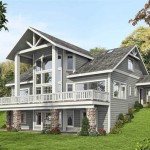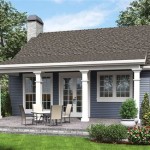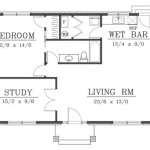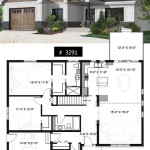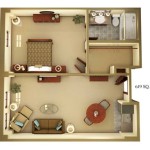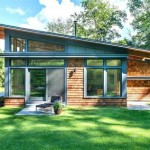1 Bedroom Small House Plans: Maximizing Functionality and Style in Limited Spaces
The demand for efficient and affordable housing solutions has led to a surge in interest in 1 bedroom small house plans. These plans offer a practical approach to homeownership or renting, particularly for individuals, couples, or those seeking minimalist living. Effective 1 bedroom small house plans prioritize intelligent space utilization, cost-effectiveness, and adaptability to various lifestyle needs.
Designing a small house with only one bedroom requires careful consideration of every square inch. The goal is to create a comfortable, functional, and aesthetically pleasing living environment within a compact footprint. This article will explore key aspects of 1 bedroom small house plans, including design considerations, space-saving strategies, and common layout options.
Understanding the Core Principles of Small House Design
Successful small house design hinges on a few core principles. These principles guide the entire planning process, ensuring the resulting structure is both practical and comfortable.
One fundamental principle is
prioritization of needs
. Before even looking at floor plans, prospective homeowners must clearly define their essential requirements. This involves identifying the activities that will take place within the home, the amount of storage necessary, and any specific accessibility needs. This process helps to filter out unnecessary space and focus on what truly matters.Another crucial principle is
maximizing vertical space
. In small houses, the effective use of height can dramatically increase storage and living possibilities. This can include features like lofted beds, built-in shelving that extends to the ceiling, and high windows that bring in ample natural light. Verticality helps to avoid a cramped feeling and creates a sense of openness.Finally,
multifunctional spaces
are essential in small house design. Rooms must be designed to serve multiple purposes. For example, a living room might also act as a dining area and home office. Furniture should be chosen for its versatility, such as sleeper sofas, folding tables, and storage ottomans. This approach allows a limited number of rooms to accommodate a wide range of activities.Key Design Considerations for 1 Bedroom Small House Plans
Several design considerations are particularly important when working with 1 bedroom small house plans. These factors influence the overall functionality, comfort, and aesthetic appeal of the dwelling.
Layout and Flow:
The layout of a small house should promote smooth traffic flow and avoid cramped or awkward areas. Open-concept designs are often preferred as they create a sense of spaciousness and allow natural light to penetrate throughout the home. However, even in open-concept designs, it is important to define distinct zones for different activities. The bedroom should ideally be located away from high-traffic areas to ensure privacy and quiet.Natural Light and Ventilation:
Adequate natural light and ventilation are crucial for creating a healthy and comfortable living environment, especially in a small space. Large windows, skylights, and strategically placed doors can maximize natural light. Cross-ventilation, achieved by placing windows on opposite sides of the house, can help to keep the air circulating and reduce the need for artificial cooling. The use of light-colored walls and ceilings can further enhance the effect of natural light.Storage Solutions:
Storage is a critical consideration in any small house plan. Built-in storage solutions, such as shelving, cabinets, and drawers, are highly effective in maximizing space. Utilizing under-bed storage, incorporating storage into stairs, and installing shelving above doorways are all smart strategies for keeping clutter at bay. A well-organized storage system not only minimizes the visual impact of belongings but also makes it easier to maintain a tidy and functional living space.Bathroom Design:
The bathroom in a 1 bedroom small house should be designed for efficiency. Compact fixtures, such as wall-mounted toilets and corner sinks, can save valuable space. A shower-only configuration, rather than a bathtub, is another common space-saving choice. Light colors, ample lighting, and a large mirror can make the bathroom feel more spacious.Kitchen Design:
The kitchen is often the heart of a home, even in a small house. Efficient kitchen design involves optimizing the layout and choosing appliances that are appropriately sized. Galley kitchens and L-shaped kitchens are popular choices for small homes as they maximize counter space and storage. Compact appliances, such as a 24-inch refrigerator and a combination microwave/convection oven, can further save space. Open shelving can provide easy access to frequently used items, while closed cabinets can conceal clutter.Space-Saving Strategies for 1 Bedroom Small House Plans
The successful implementation of 1 bedroom small house plans relies heavily on the deployment of effective space-saving strategies. These strategies encompass furniture selection, design modifications, and clever use of materials.
Multifunctional Furniture:
As previously mentioned, multifunctional furniture is a cornerstone of small house design. A sleeper sofa can serve as both a couch and a guest bed. A coffee table with built-in storage can provide a place to store blankets, books, or other items. A dining table that can be folded away when not in use can free up valuable floor space. The key is to choose furniture that serves multiple purposes without sacrificing comfort or style.Built-in Features:
Built-in features, such as shelving, benches, and window seats, can maximize space and add character to a small house. These features can be customized to fit the specific needs and dimensions of the space. A built-in bookshelf can provide ample storage for books and decorative items, while a built-in window seat can offer a cozy reading nook and additional storage underneath.Vertical Storage:
Extending storage upward is essential in small houses. Tall shelves, cabinets that reach the ceiling, and lofted beds are all effective ways to utilize vertical space. High shelves can be used to store items that are not frequently needed, while lower shelves can be reserved for everyday essentials. A lofted bed can free up floor space for a desk, seating area, or storage.Mirrors:
Mirrors can create the illusion of more space by reflecting light and expanding the visual boundaries of a room. A large mirror placed on a wall opposite a window can significantly brighten a room and make it feel larger. Strategically placed mirrors can also be used to create the illusion of depth in narrow hallways or small bathrooms.Sliding Doors:
Traditional swinging doors can take up valuable floor space, especially in small houses. Sliding doors, such as pocket doors or barn doors, can be a space-saving alternative. These doors slide along a track, eliminating the need for a swing radius and freeing up floor space. Sliding doors can be particularly useful for closets, bathrooms, and other small rooms.Common Layout Options for 1 Bedroom Small House Plans
Several common layout options are well-suited for 1 bedroom small house plans. These layouts offer a variety of configurations and can be adapted to suit different needs and preferences.
Open-Concept Layout:
An open-concept layout combines the living room, dining area, and kitchen into a single, unified space. This layout promotes a sense of spaciousness and encourages interaction between different areas of the home. Open-concept layouts are particularly well-suited for small houses as they eliminate the need for walls and doors that can take up valuable space. Zoning can be achieved through the strategic placement of furniture and the use of area rugs.Linear Layout:
A linear layout arranges all rooms along a single axis. This layout is often used in narrow or rectangular houses. The living room, kitchen, and bedroom are typically arranged in a row, with the bathroom located off to the side. Linear layouts can be efficient and easy to navigate, but they may require careful planning to ensure adequate natural light and ventilation throughout the home.L-Shaped Layout:
An L-shaped layout features two wings that intersect at a right angle. This layout can be used to create a sense of separation between different areas of the home. The living room and kitchen are often located in one wing, while the bedroom and bathroom are located in the other. L-shaped layouts can be particularly well-suited for corner lots as they maximize the use of available space.Studio Apartment Layout:
A studio apartment layout combines the living room, bedroom, and kitchen into a single, open space. The bathroom is typically the only separate room. Studio apartment layouts are the most compact option and are often used in urban settings. Effective zoning is crucial in a studio apartment to create a sense of order and functionality.Loft Layout:
A loft layout features a raised sleeping area that is accessed by a ladder or stairs. The space underneath the loft can be used for a living room, kitchen, or storage. Loft layouts are a popular choice for small houses as they maximize vertical space and create a unique architectural feature.
International House 1 Bedroom Floor Plan Top View One Plans

Small 1 Bedroom House Plan Plans Tiny Floor Guest

1 Bedroom House Plan Examples

1 Bedroom House Plan Examples

1 Bedroom Apartment House Plans Home Decoration World Small Tiny

House Plan 1 Bedrooms Bathrooms 1901 Drummond Plans

With 1 Bed 2 Bath One Bedroom House Plans Small Floor

42 Skippy 1 Bedroom House Plan Home

Cottage Like One Bedroom House Pinoy Plans

1 Bedroom Apartment House Plans

